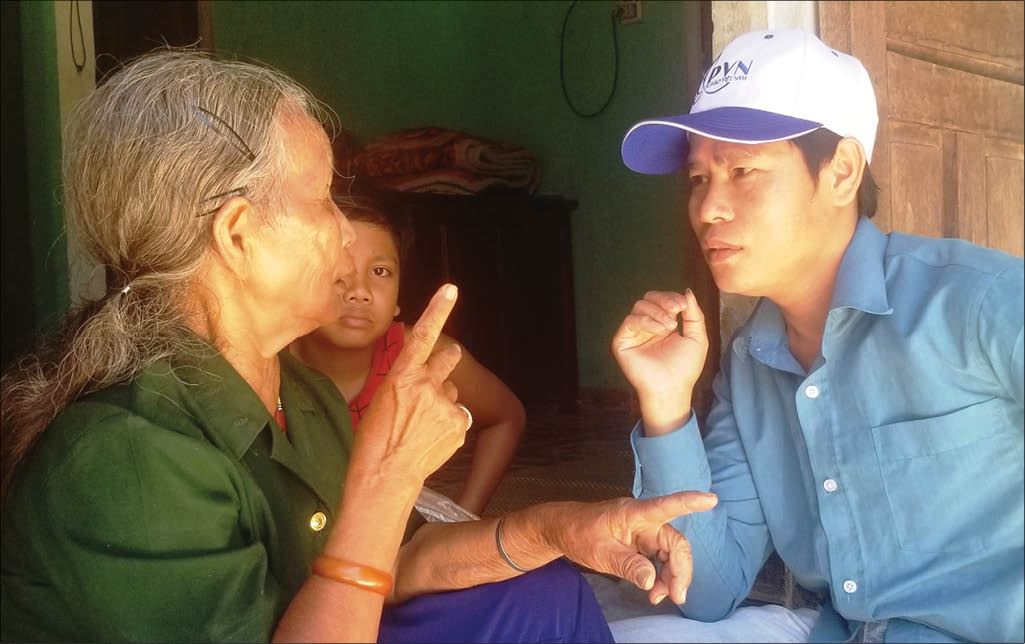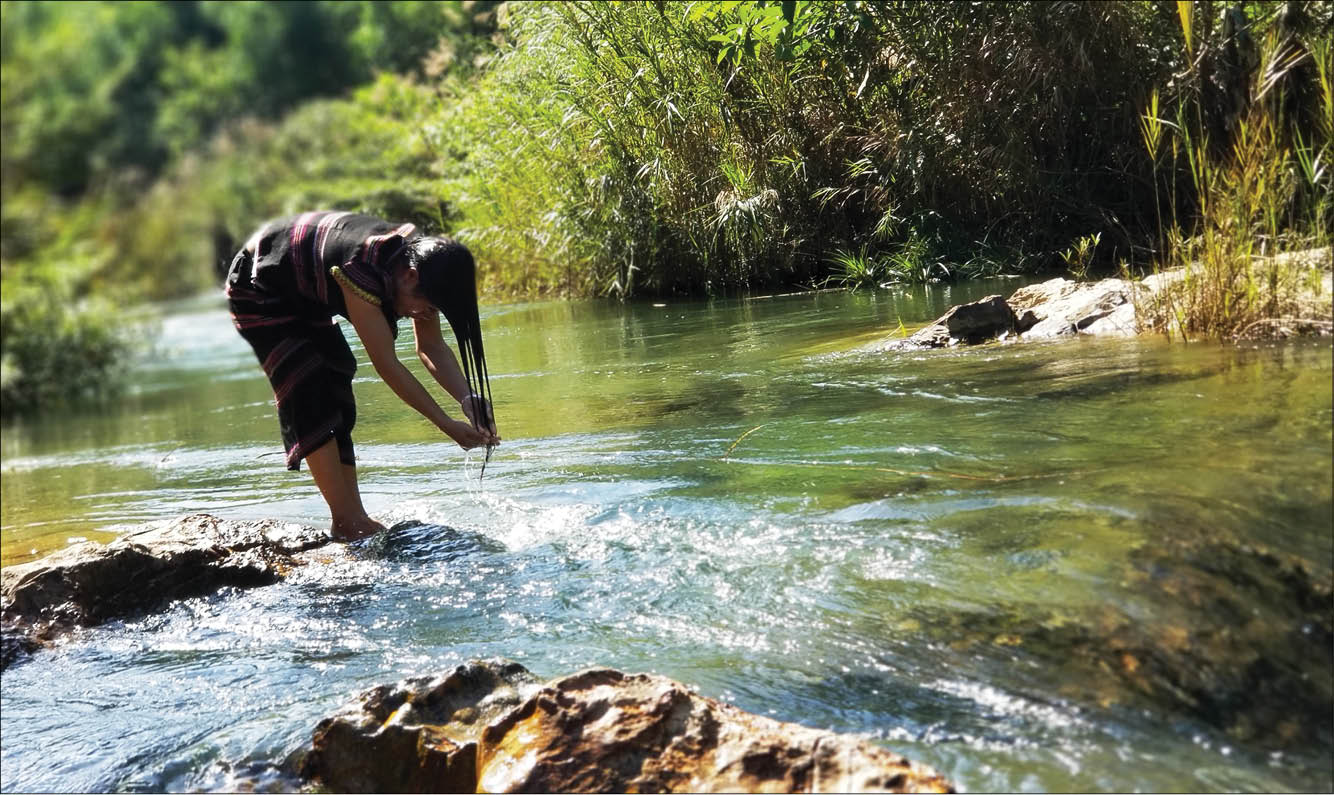
Downstream of Mau stream is a picturesque scenery
Festivals by the Mau stream
The clear, picturesque stream soothes the dazzling sunshine of the last days of summer. Upstream of the Mau stream, many people in the uplands still cling to the water.
For many, the memories of the stream are also the memories of their lives. Mrs. Ho Thi Cuc (hamlet 4, Hong Tien commune) has lived to see more than 80 rice-growing seasons. She did not speak the Kinh tongue (Vietnamese language) well, but when it came to the Mau stream her voice seemed to mingle with the sound of murmuring water. Her eyes were deep with a faraway look. Suddenly she mentioned her family, her husband and her children. “I was not born here, but more than half of my life has been attached to this stream. In the past, my husband and my parents fought the enemy here,” Mrs. Cuc said.
More than 40 years ago, the upstream of this stream was a desolate, mysterious place, a testament to the glorious battles of our soldiers. The origin of the historical stories related to Mau stream might not be remembered so clearly, but many Hong Tien people spread the story about the blood of the enemy dyeing the water red. Thus, the name of the stream which cuts through Highway 49 was born.
“Along this stream, the Co Tu people of hamlet 4 have spent their lives together, making a living and unburdening each other’s tribulations”, Mrs. Cuc shared.
Similar to the many people relying on the mountains for a living, the Co Tu Hamlet 4 people have “wandered” through many lands before settling down to live in the plains, next to the stream and integrated with the 9 ethnic groups. In the memory of the people here, the stream is legendary and has helped many people. Finally, the fate of people and the stream have intertwined. The stream at times is calm and gentle, and at times is angry and fierce.
Standing at the bank of Nghe creek, a branch of the stream, Mr. Ho Van Thom (83 years old, village 4, Hong Tien commune) nostalgically recalled the old days. He talked about the forest trips, along the banks of the stream looking for forest products, and goods of the people on the rafts going upstream and downstream.
This detail made me think that this place used to be a trading hub for the Co Tu people. But Mr. Thom shook his head, saying that it was just a way the Co Tu people took advantage of transporting forest products. There was no trade when they were still busy with their nomadic life along the stream. With his life attached to the water since he was still a boy until old age, his eyes are still as clear as cool spring water.

Ms. Ho Thi Cuc telling the history of the migration of the Co Tu people to the Mau stream
“Mau stream (Blood stream) is just a name, but there are many stories associated with it. But there are two things that the people of hamlet 4 must know: where their ancestors chose to settle down to build the village and the place where our army defeated the enemy. The stream helps our people to have water to drink and fish to eat. But in the rainy season, the streams can be fierce and violent, sweeping away all,” Mr. Thom shared.
Out of 79 households of hamlet 4, the majority are Co Tu people who followed their ancestors from Ta Ve village (Huong Nguyen commune, A Luoi district) to Hong Tien. They followed the stream to find food and took advantage of the water for irrigation and everyday life. With that, they have also brought the Co Tu culture to this land.
Mr. Rapat Van, Head of hamlet 4 said: “Our origin is in A Luoi. In the old days, we went to whichever place that could support our living. We came to the lush land next to the Mau stream and settled down. Now the stream is like our flesh and blood, filled with love. "
Hong Tien commune is home to many ethnic minorities, but the Co Tu of hamlet 4 have always been distinctive with their own identity and customs that other local people do not have.
“In addition to joining the festivals with the ethnic groups in the commune, every year, we organize festivals of our own people to preserve our ethnic identity such as new rice-eating ceremony, A za and tung da dancing. Moreover, handicrafts such as weaving are also maintained by the elderly...” Mr. Van proudly said.
Cool water and lush greenery
At the same time the Co Tu people immigrated to Hong Tien, many other ethnic groups also chose this land to settle down. Instead of choosing the terrain down towards the plains, the Co Tu people chose the area around Mau stream and considered this to be the ‘mother water’.

Mau stream - a place to preserve the history and culture of the local people
Now, when they have nestled upstream, the clear water from this place creeps through many rocks, piercing through the leaves, and falling downstream to create magnificent scenery. The stream has meanderings; at places, the bottom can be seen. There are also places where steep water runs fast creating white foam. On the stream, the stone tables (large rock surface) help visitors admire the charming natural scenery.
I had the chance to explore Mau stream with the Vice Chairman of the People's Committee of Hong Tien Commune, Mr. Le Van Chau. Immersed in the airy, peaceful, remote space with the local girls letting their hair loose in the cool water, Mr. Chau said the local authority is planning to turn this stream into a tourist spot in the future.
“The stream water is cool and clear thanks to the upkeep of the people upstream. Since the 90s of the last century, upstream of the Mau stream has been the settlement of many Co Tu people who migrated from A Luoi. They chose the land next to the Mau stream because of its lush greenery and the many products that the land offered. Now, they are used to life among the mountains, forests, rivers and streams,” Mr. Chau said.
Listening to the story of tourism and a tourism development project from Mr. Chau, I envision that the stream will not "sleep". The waking stream will create an interesting destination halfway up the hill.
Story and photos: Quynh Vien
